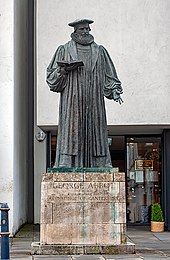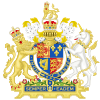George Abbot (bishop)
Anglican |
|---|
George Abbot (29 October 1562 – 4 August 1633)
Life and career
Early years
Born at

Archbishop of Canterbury
On 4 March 1611, Abbot was raised to the position of Archbishop of Canterbury. As archbishop, he defended the apostolic succession of Anglican bishops and the validity of the church's priesthood in 1614. In consequence of the Nag's Head Fable, the archbishop invited certain Roman Catholics to inspect the register in the presence of six of his own episcopal colleagues, the details of which inspection were preserved. It was agreed by all parties that:
The register agrees in every particular with what we know of the history of the times, and there exists not the semblance of a reason for pronouncing it a forgery.[11]
In spite of his defence of the catholic nature of the priesthood, his
In July 1621,

After this, the Archbishop seldom appeared at the council, chiefly on account of his infirmities. In 1625 he attended the King constantly, however, in his last illness, and performed the ceremony of the coronation of King Charles I as king of England. His refusal to license the assize sermon preached by Robert Sibthorp at Northampton on 22 February 1627, in which cheerful obedience was urged to the king's demand for a general loan, and the duty proclaimed of absolute non-resistance even to the most arbitrary royal commands, led Charles to deprive him of his functions as primate, putting them in commission. The need of summoning parliament, however, soon brought about a nominal restoration of the Archbishop's powers. His presence being unwelcome at court, he lived from that time in retirement, leaving Laud and his party in undisputed ascendancy. He died at Croydon on 4 August 1633, and was buried at Guildford, his native place, where he had endowed Abbot's Hospital with lands to the value of £300 a year.[2]
Legacy

Abbot was a conscientious prelate, though narrow in view and often harsh towards both separatists and Roman Catholics. He wrote a large number of works, the most interesting being his discursive Exposition on the Prophet Jonah (1600), which was reprinted in 1845. His Geography, or a Brief Description of the Whole World (1599), passed through numerous editions.[2] The newest edition, edited by the current Master of the Abbot's Hospital, was published by Goldenford Publishers Ltd on 20 June 2011, to commemorate the 400th anniversary of his enthronement as Archbishop of Canterbury.
Abbot had a large private library of more than 8000 volumes, the majority of which he left to Lambeth Palace Library. Books bearing his armorial stamp can still be found in libraries today.[14]
Guildford remembers the Archbishop with his hospital[15] and a statue in the High Street. A secondary school and a pub in the High Street are named after him. His tomb can be found in Holy Trinity Church.[4]
Notes
- ^ Other sources, such as the 1911 Encyclopædia Britannica give his birth and death dates as 19 October 1562 – 5 August 1633,[2] but the majority of sources state he was born 29 October 1562,[3][4] and the date 4 August 1633 is inscribed on his tomb
- ^ This ceased to be true, by some definitions, in 1980 with the appointment of former soldier and Military Cross recipient Robert Runcie. Abbot remains the only known Archbishop of Canterbury to kill while in office.
References
- ^ Oldys, William (1777). The life of Dr. George Abbot, Lord Archbishop of Canterbury – via Text Creation Partnership.
- ^ a b c d e f Chisholm, Hugh, ed. (1911). . Encyclopædia Britannica. Vol. 1 (11th ed.). Cambridge University Press. pp. 22–23.
- ^ doi:10.1093/ref:odnb/4. (Subscription or UK public library membershiprequired.)
- ^ a b Lee, Sidney (1885). . In Stephen, Leslie (ed.). Dictionary of National Biography. Vol. 1. London: Smith, Elder & Co. p. 5.
- ISBN 978-0-19-928429-0. George Abbot, pages 120–126
- ^ Abbot, George in the Christian Cyclopedia
- Thomas Ulick Sadleirp1: Dublin, Alex Thom and Co, 1935
- ^ ISBN 055016040X.
- ^ Lee, Sidney (1885). . In Stephen, Leslie (ed.). Dictionary of National Biography. Vol. 1. London: Smith, Elder & Co. pp. 21–24.
- ^ Society of gentlemen (1780). The Biographical Dictionary, Or, Complete Historical Library: Containing the Lives of the Most Celebrated Personages of Great Britain and Ireland, Whether Admirals, Generals, Poets, Statesmen, Philosophers, Or Divines: a Work Replete with Instruction and Entertainment. F. Newbery. p. 5.
- ^ John Wordsworth, D.D., Bishop of Salisbury (13 May 1890). "A Letter on the Succession of Bishops in the Church of England". Project Canterbury. Retrieved 5 October 2008.
{{cite web}}: CS1 maint: multiple names: authors list (link) - ^ BBC History, July 2011, p. 12
- ^ Paine, Gustavus S (1977). The Men Behind the King James Version. Baker. p. 157.
- ^ "George Abbot 1562-1633 - Book Owners Online". www.bookowners.online. Retrieved 8 August 2022.
- ^ Abbot's Hospital, retrieved 9 January 2016

